Abstract
The substantial impact of the heating and cooling of the construction sector on global warming necessitates a focus on effective thermal insulation solutions to mitigate high CO2 emissions. Thus, the development of efficient low-temperature thermochemical energy storage (TCES) materials offers a promising approach to improve thermal regulation. This study explores the morphological, physicochemical, and thermal properties of a silicon composite (PDMS foam) filled with calcium L-lactate (CaL) (0–70 wt.%) for the core sandwich thermopassive regulation of buildings. Furthermore, CaL was incorporated into a composite form to improve the handling and processability of the final sandwich material, as CaL is available in powder form. The results demonstrated that the filler is entirely confined within the polymer matrix (FTIR and ESEM). Additionally, the CaL-PDMS composites showed fully reversible dehydration/hydration abilities over a water vapor hydration–dehydration cycle within a temperature range suitable for low-temperature TCES, with no performance loss due to salt confinement. Regarding the energy density, the 70 wt.% CaL-PDMS composites achieved a value up to 955 MJ/m3, making it an excellent candidate for low-temperature energy storage in the construction sector as compared to other similar composites. These findings contribute to the development of new thermopassive regulation techniques for building materials.
1. Introduction
The ever-growing global demand for energy, coupled with the urgent need to reduce greenhouse gas emissions, has led to an increased focus on sustainable energy systems worldwide. The building sector is one of the most critical areas to investigate, as it is a major contributor to global energy demand and associated greenhouse gas emissions. According to Eurostat energy balances and the EEA Greenhouse Gas Inventory of 2023, approximately 40% of the energy in Europe is used in buildings, and approximately 50% of the EU’s gas consumption is attributable to them. Furthermore, approximately 80% of the energy used in EU homes is attributable to heating, cooling, and hot water []. Thermal energy storage (TES) materials play a critical role in improving the efficiency and reliability of renewable energy sources applied to the building materials sector. By storing excess thermal energy for later use, TES systems can bridge the temporal mismatch between energy supply and demand, thereby enabling a more flexible and resilient energy infrastructure. TES technologies are generally categorized into three types: sensible heat storage (SHS), latent heat storage (LHS), and thermochemical energy storage (TCES) []. In this scenario, passive thermoregulation energy savings and enhancing the sustainability of construction material strategies have gained considerable attention in guaranteeing thermal comfort despite low energy consumption. Mesoporous composite materials have become highly relevant in advanced TES applications in built environments owing to their tailored structures and properties. They have been developed to improve the energy storage capacity and increase the stability of the adsorbents within composites by employing various salts of different natures and quantities [,].
LHS systems are currently the most widely used in developing “envelope” materials designed to create a comfortable indoor thermal environment in buildings. These systems utilize heat charging and discharging processes by harnessing the properties of Phase Change Materials (PCMs). These materials can be seamlessly integrated into various building components, including walls [], interiors [], and windows []. Gao et al. [] developed a triple-layer sandwich structure for manufacturing gypsum boards, incorporating diatomaceous earth, expanded graphite, and a mixture of fatty acids to improve the energy efficiency of buildings. Jeong et al. [] introduced n-octadecene and beeswax into the interior of cement gypsum boards to evaluate their performance under varying thermal conditions. Hattan et al. [] created plaster masonry brick wall specimens using Shape-Stabilized PCM (SSPCM) by integrating PEG600 and silica fume into the mortar. Zhang et al. [] developed a composite PCM comprising CaCl2·6H2O and mannitol with SiO2, intended for use in a radiant cooling panel system within low-carbon buildings. However, despite the numerous benefits of incorporating PCMs into various construction materials, several challenges persist, including leakage issues with PCM components in composites (deliquescence), high costs, toxicity, and fire hazards [].
Thermochemical energy storage is a promising solution for residential buildings, particularly for long-duration and low-temperature storage conditions. TCES relies on reversible chemical reactions to store and release energy, offering significantly higher energy densities than sensible or latent heat storage. Moreover, thermochemical systems can minimize thermal losses over time because energy is stored in chemical bonds rather than in temperature or phase changes. In a typical thermochemical heat storage system, energy is stored through an endothermic reaction in which heat drives a chemical transformation, usually the decomposition of a compound. When energy is required, a reverse exothermic reaction is initiated, releasing heat as the products recombine into the original compound. The general formula for this reversible reaction is as follows:
where represents the thermochemically active compound, while and are the decomposition products. The enthalpy change behavior () corresponds to the amount of thermal energy stored or released during the reaction. This reversible reaction is the foundation of many thermochemical storage materials, allowing them to be charged and discharged repeatedly without significant loss of capacity or efficiency [].
Among the various classes of materials explored for TCES, inorganic salts, particularly salt hydrates like LiCl, CaCl2, MgSO4, and SrCl2, have garnered significant attention [,,,,]. The primary advantages of salt hydrates include high energy density, availability, and low material costs. Various types of mesoporous composites have been employed to mitigate the deliquescence of inorganic salts and have become highly valuable for improving energy consumption in the building sector; composites with excellent adsorption capacities include mesoporous silica gel impregnated with LiCl [], and CaCl2 [], as well as microstructured cellular foam zeolite/silica gel []. Other composites that perform exceptionally well in encapsulating inorganic salts are zeolites due to their excellent structural organization, where the size of pores, channels, and boxes can be modified, and various families of zeolites [], such as NaX and Mordenite [,]. Alternatively, materials like porous carbon [] and metal–organic frameworks (MOFs) [,] have been employed as excellent porous host matrices due to their remarkable hybrid versatility. Despite the significant advancements in developing various porous composites for the adsorption of hydrated inorganic salts, challenges remain due to solution deliquescence between the pores caused by expiration and shrinkage processes resulting from numerous water adsorption–desorption cycles. Furthermore, long-term stability under cyclic thermal and mechanical stresses is a critical requirement for energy storage systems, as it affects composite integrity and overall system lifespan [,].
Recent innovations in siloxane foam composites have allowed it to emerge as an exceptionally versatile and promising platform for advancing thermochemical energy storage materials []. These lightweight, porous composite materials not only showcase remarkable thermal stability but also exhibit outstanding vapor permeability and mechanical flexibility, making them ideal candidates for hosting active thermochemical components. Traditionally, siloxane foams have been used as supportive matrices for zeolite particles, where they play a dual role: first, by physically stabilizing the often-fragile sorbent particles, and second, by improving heat and mass transfer within the composite structure []. The open-cell architecture of the foam provides an interconnected pore network, facilitating vapor transport and reducing the diffusion limitations that often impair the performance of conventional bulk-packed beds []. Moreover, the potential applications of siloxane foams have expanded beyond zeolites to include salt hydrates like magnesium sulphate heptahydrate (MgSO4·7H2O) [] and lithium chloride monohydrate (LiCl2·H2O) [,] in cutting-edge TCES systems. Recently, the incorporation of silicon, alumina (Al2O3), and calcium carbonate (CaCO3) mineral fillers into siloxane-based materials foams has been demonstrated, with the aim of evaluating them as fire-resistant composites for building materials []. In addition to these, other fillers such as MOFs and carbon-based nanomaterials (e.g., graphene oxide) may offer promising alternatives for enhancing the energy storage performance of open-cell PDMS matrices [].
Embedding these salts into a siloxane foam matrix can mitigate key challenges associated with salt hydrate use, including deliquescence, material agglomeration, and mechanical degradation during hydration–dehydration cycles. The foam serves as a confinement and distribution medium, dispersing the salt hydrate more uniformly and preventing the formation of dense crystalline clusters that hinder heat transfer and reduce cycle life. Moreover, the dimensional stability of siloxane foams under repeated thermal cycling helps preserve the geometric integrity of storage modules, a crucial consideration for system integration in real-world applications [,].
The development of new strategies for materials with thermal heat storage properties, with the objective of preventing/limiting the phenomenon of deliquescence, has been proposed using insoluble organic salts. Organic salts (carbon-based molecules) can set up more stable conditions in adsorption–desorption processes because they can coordinate a high number of water molecules from their environment, inducing great polymorphic versatility due to their physicochemical properties and great adaptability to different specific temperatures []. Organic salts derived from L-lactic acid have been the subject of study because of their importance in various commercial sectors, their non-toxicity, and their low cost [].
This novel approach of using organic salt hydrates as CaL offers a promising alternative to overcome the typical limitations associated with inorganic salt hydrates. It may provide advantages in terms of stability, low cost, toxicity, and improved environmental compatibility. Among the salts derived from L-lactic acid, calcium L-lactate (CaL) is one of the most important, as it is widely used in both the food and pharmaceutical sectors []. Recently, our research group reported the thermochemical behavior of CaL, owing to its great versatility in terms of structural and physicochemical properties during hydration–dehydration cycles, with the aim of using it as a material for low-temperature thermochemical energy storage applications [].
In this study, we provide a physicochemical understanding of the behavior of dispersed CaL at several weight percentages (40–70 wt.%), hosted in a composite PDMS-based foam, obtaining a flexible and macroporous matrix facilitating water vapor flow during the expansion and shrinkage of calcium L-lactate salt during the thermochemical heat storage process. In this regard, the development of composite CaL-PDMS foams offers a viable pathway for the direct integration of efficient thermal energy storage into building structures; this innovation holds substantial promise for creating smarter buildings that are more energy-resilient and environmentally friendly and that can act as absorbers of excess solar energy during the day and release it as needed, thereby reducing reliance on conventional heating and cooling systems and lowering operational carbon footprints.
2. Materials and Methods
2.1. CaL-PDMS Foam Synthesis and Characterization
The synthesis of a composite foam structure with varying CaL contents was carried out according to the procedure reported by Calabrese et al. [] (see synthesis scheme reported in Figure 1). In summary, the polymers poly(methylhydrosiloxane) (PMHS) and silanol-terminated polydimethylsiloxane (PDMS) (both supplied by Gelest Inc., Morrisville, PA, USA) were used in a 2:1 ratio (PMHS–PDMS) and slowly mixed with pure ethanol (Sigma-Aldrich, St. Louis, MO, USA). Different amounts of CaL dehydrate were slowly added to the mixture of the polymers. The anhydrous form of the calcium L-lactate was obtained by drying the pentahydrate form (0–70 wt.%—Sigma Aldrich) of the salt overnight at 80 °C.
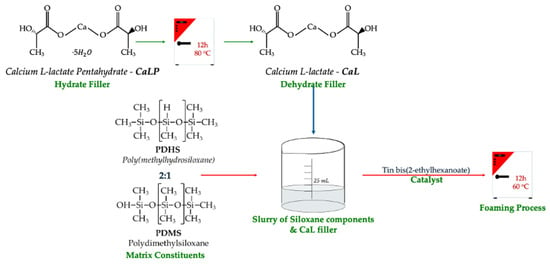
Figure 1.
Scheme of the synthesis method for composite CaL-PDMS foam, matrix.
The amount of ethanol used was directly proportional to the quantity of organic salt added to improve the homogenization of the mixture and its viscosity. Table 1 summarizes the synthesis parameters of the foams at varying CaL contents. The different CaL-PDMS foam composites obtained are denoted with the prefix “FM,” combined with a number indicating the amount by weight percentage of the dehydrated organic salt used with respect to the total weight of the solid precursors (PDMS, PMHS, and CaL). To activate the dehydrogenative coupling reaction between the silane polymers (foaming agent), 6 wt.% Tin(bis(2-ethylhexanoate)) (Gelest Inc., Morrisville, PA, USA) was added. The mixture was stirred vigorously for 60 s to homogenize the slurry. Finally, the liquid mixture was poured into a 10 mL cylindrical aluminum mold and kept in an oven at 60 °C overnight (12 h). The reaction between poly(methylhydrosiloxane) (PMHS), polydimethylsiloxane (PDMS) drives the foaming process by generating hydrogen gas bubbles and crosslinking the matrix, resulting in a three-dimensional macroporous silicone structure.

Table 1.
Composition of the starting mixture used for the composite foam preparation.
The weight percentage (wt.%) of CaL content within the PDMS foam composite was determined according to Equation (1):
The ethanol content was excluded from Equation (1) because it was expected to evaporate during the foaming process.
2.2. Physicochemical and Morphological Characterization of the Composite Foams
An Attenuated Total Reflectance Infrared Spectrophotometer (ATR-FTIR, Spectrum Two, PerkinElmer Inc., Waltham, MA, USA) was used for the chemical characterization of CaL, CaL-PDMS composite, and siloxane compounds. Prior to characterization, the samples were dehydrated in a dry air oven overnight at 80 °C (except for the siloxane polymers). A small amount of sample was placed on the diamond crystal base, and moderate pressure of approximately 60% was applied to the samples. FTIR spectra were recorded in a wavelength range of 4000–500 cm−1 using 16 scans. The instrument has a spectral resolution of 4 cm−1 for solid samples.
The homogeneity and distribution of the internal bubbles of the CaL-PDMS composite foams were analyzed by using the 2D scanning property in the cross-sectional area of the composite using a 3D Digital Optical Microscope (Hirox HK-8700, Tokyo, Japan) at a magnification of 50.
Statistical analysis of the bubble distribution of the composite foams was performed using digital image analysis software: first with Inkscape® software (Version 1.2) to identify all possible voids, followed by void counting with ImageJ® software (Online version-ij.imjoy.io), and finally, statistical evaluation of the internal bubble distribution using OriginLab (Version 2018) and Excel (Version 16.102.1).
The surface morphology of the composite CaL-PDMS foams in their hydrated state was examined using an Environmental Scanning Electron Microscope (ESEM, FEI Quanta 450, Thermo Fisher Scientific, Waltham, MA, USA) set to an accelerating voltage of 2 kV under high vacuum (SE detector) and a magnification of 100 and 1000. The bulk density of the composite foams was determined using a pycnometer (Ultrapyc 3000; Anton Paar Quanta Tec, Boynton Beach, FL, USA) in a nitrogen atmosphere at 20 °C. The samples were heated in a furnace under static air for 2 h at 80 °C before the density measurement.
2.3. Hydration–Dehydration Cycle Through Thermogravimetric Dynamic Vapor Sorption System
A Dynamic Vapor Sorption (DVS Vacuum Surface Measurement Systems) system was utilized to assess the water uptake (change in mass) of the composite siloxane during a controlled hydration–dehydration cycle at a constant temperature of 30 °C by increasing the relative humidity (RH) from 0 to 90% to measure the sorption capacity and from 90 to 0% to measure the desorption capacity. Increments were applied in 5% steps across the 0 to 35% range and in 10% steps across the 40–90% range for the adsorption–desorption process. The system featured a microbalance with a precision of ±0.1 mg and a controller to regulate the water vapor pressure (42 mbar at 30 °C) within the measurement chamber. A 10 mg sample of composite PDMS-CaL was initially dehydrated at 80 °C overnight in an oven and then placed in the measurement chamber of the DVS instrument, degassing the sample again at 80 °C under vacuum for 3.5 h to ensure the complete dehydration of the material prior to the first sorption step.
2.4. Dehydration Enthalpy Measurements
The dehydration enthalpy measurements were performed on ~30 mg of CaL-PDMS composite foams using a TGA/DSC instrument (Q600 TA-Instruments, Waters Corporation, Milford, MA, USA). Prior to analysis, samples were dehydrated in a dry air oven at 120 °C for 2 h, followed by hydration in a climatic chamber (Memmert HCP, Memmert GmH + Co. KG, Büchenbach, Germany) at 35 °C and 90% relative humidity overnight. The enthalpy was measured under isothermal conditions at 80 °C for 2 h in an argon atmosphere, using a heating rate of 5 °C/min. The instrument was calibrated using standard reference materials, and measurements were performed in triplicate. Reported enthalpy values were normalized per gram of CaL content in the composite.
3. Results
3.1. Chemical Analysis
The structural chemical analysis of the components of the composite CaL-PDMS was performed with ATR-FTIR spectroscopy. The spectra of the siloxane polymers PDMS (Figure 2a) and PMHS (Figure 2b) were analyzed as received, while Figure 2c corresponds to the dehydrated salt FTIR spectra. Regarding the siloxane component spectra, characteristic signals can be seen in the bands at 2963 cm−1 (CH3 asymmetric vibrational stretching), 1410 cm−1 (Si-CH3 symmetric deformation), 1258 cm−1 (Si-C stretching vibration mode), and 783 cm−1 (symmetric stretching vibration) []. A characteristic doublet is observed at 1078 cm−1 and 1010 cm−1, which correspond to the bands of the symmetric stretching vibrations of the Si-O-Si group due to bonding with adjacent methyl groups. Asymmetric stretching vibrations in the Si-O-Si group were observed at 883 cm−1 []. However, the FTIR spectra of PMHS (Figure 2b) show the presence of stretching vibrations in the Si-H group at 2158 cm−1 [].
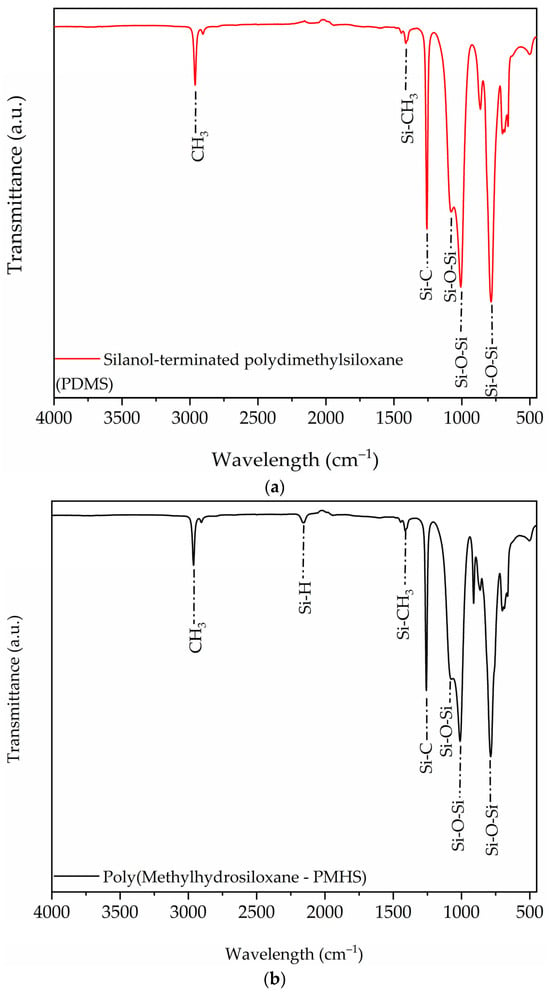
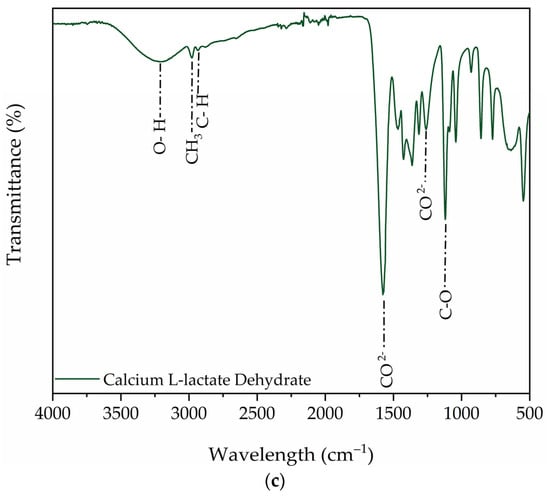
Figure 2.
ATR-FTIR spectra of (a) PDMS, (b) PMHS, and (c) calcium L-lactate (CaL).
The dehydrated CaL FTIR spectra (Figure 2c) show the characteristic broad peak of O-H stretching vibrations with a maximum at 3131 cm−1. Furthermore, symmetric and asymmetric stretching at 2984 cm−1 and 2932 cm−1 in the CH3 and CH groups, respectively, can be identified []. Two intense peaks at 1567 cm−1 and 1394 cm−1 describe the symmetric and asymmetric vibrations of the carboxylic group (), and at 1118 cm−1, we can see the adsorption band of the stretching vibration in the C-O group [].
A low intensity in the O-H stretching band corresponds to the prior dehydration of the organic salt, which does not show a structural modification when the CaL is hydrated, as evidenced by a higher-intensity O-H stretching band []. Finally, in the FTIR spectrum of the dehydrated salt, the characteristic peaks for stretching or bending the metal–oxygen bond in the carboxylate group cannot be observed because the characteristic signal is below 400 cm−1, outside the range of the instrument used for the characterization.
The chemical interactions within the dehydrated salt; the composite foam; and the FTIR spectra of the FM0, FM50, and FM70 composites are compared (see Figure 3). FM0 (black solid line) shows the characteristic absorption bands of both siloxane components at 2963 cm−1, 1410 cm−1, and 1258 cm−1 (the Si-CH3 groups) described above, as well as the vibrations in Si-O-Si at 1078 cm−1 and 1010 cm−1, without the characteristic band of the Si-H group at 2158 cm−1. In comparison, the spectrum of CaL-PDMS foam composites FM50 and FM70 (Figure 3) presents the same absorption bands observed in the matrix without filler (FM0). In addition, the presence of symmetric (1573 cm−1) and asymmetric (1415 cm−1) vibrations characteristic of the carboxylic group effectively indicates that CaL is present in the PDMS composite.
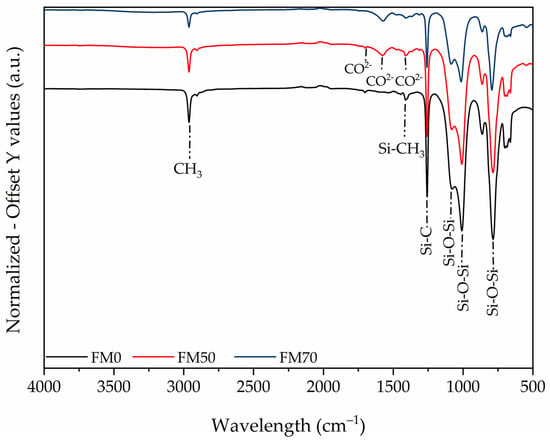
Figure 3.
FTIR spectra of composite PDMS foams: black solid line, foam without filler; red solid line, composite FM50; and blue solid line, composite FM70.
The absence of a Si-H band suggests that the coupling reaction between PDMS and PHMS likely proceeded successfully due to the reaction between the hydroxyl and hydride functional groups of the two compounds, respectively. It must be noted that, as the composites analyzed were previously dehydrated, the stretching band of the O-H group (3131 cm−1) was not observed in the FTIR spectra. At higher CaL content in the composite (FM70), a right shift of the Si-O-Si absorption band (1085 cm−1 and 1015 cm−1) was observed, potentially due to a lower amount of polymeric matrix to host the filler. The presence of CaL during this crosslinking may also lead to reactions between the unreacted silanol groups of PDMS and the carboxylic acid groups of CaL, potentially forming additional siloxane linkages that contribute to the structural reorganization of CaL during solvent evaporation in the foam formation process, as previous research has demonstrated that the incorporation of various fillers, including zeolites [] and silica [] significantly influences both the crosslinking and blowing processes within PDMS composites.
3.2. Microstructural Analysis
The structure of the synthesized composite CaL-PDMS foam has a muffin-like morphology, that is, a cylindrical structure at the base ending with a hemispherical morphology at the upper end of the composite. To carry out microstructural analysis measurements, cross-sectional direction cuts were made from the top to the bottom of all composites. A surface scan of the composite was performed using a 3D Digital Optical Microscope at 50 magnification (see Figure 4). As can be seen, all composite foams are homogenized, indicating a uniform distribution of components throughout the matrix. Notably, the dehydrated salt appeared to be thoroughly and evenly dispersed across the foam structure. Additionally, each sample exhibited a well-defined macroporous architecture characterized by interconnected voids, which suggests a mixed open–closed cell structure that may enhance permeability and material performance. It must be noted that the higher the CaL content, the lower the number of voids.
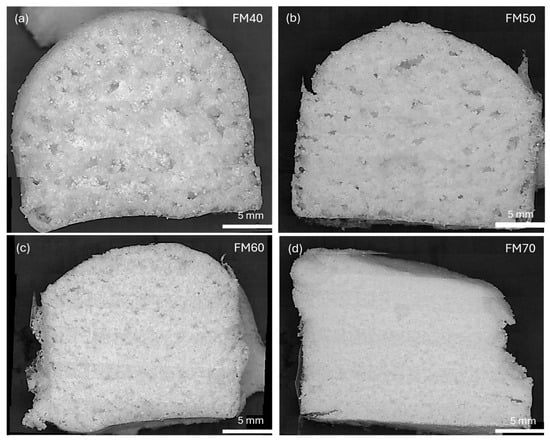
Figure 4.
Three-Dimensional Digital Optical Microscope images showing cross-sectional areas of different composite CaL-PDMS foams with different filler contents: (a) FM40, (b) FM50, (c) FM60, and (d) FM70.
To gain a clearer understanding of how the filler content influences the morphology of the foams, an analysis of the bubble (void) distribution was performed using digital image analysis using the Inkscape (Version 1.2) (see Figure 5a,c,e). This approach enables a quantitative assessment of the size, shape, and spatial distribution of bubbles within the foam structure, providing valuable insights into how varying filler concentrations impact the internal architecture and overall uniformity of the material. The circularity evolution of the void circularity (mm) vs. diameter size (mm) distribution of the CaL-PDMS foams with different wt.% filler contents was analyzed (see Figure 5b,d,f). Circularity has been calculated directly using the ImageJ (Online version-ij.imjoy.io), where low values describe an irregular morphology, and values near one describe spherical morphologies [,].
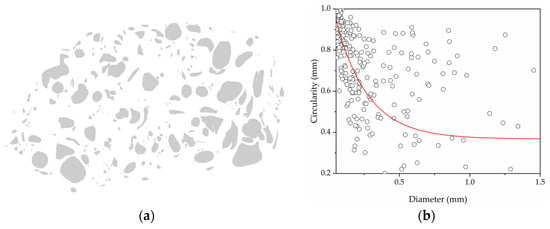
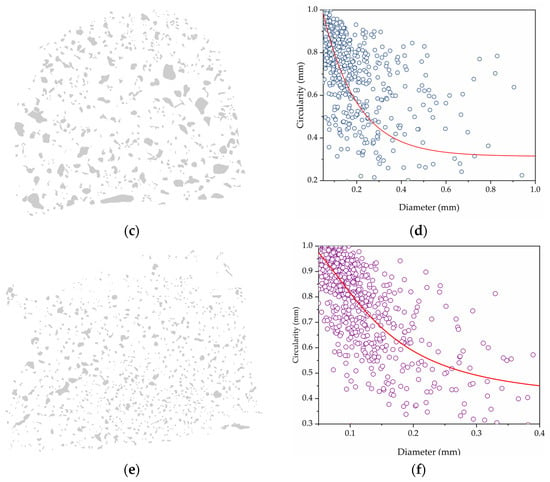
Figure 5.
Comparison of void distribution in composite CaL-PDMS foams at different wt.% contents: (a) FM0, and (c) FM40, and (e) FM70. Analysis of the fitting (red line) in the evolution of circularity distribution: (b) FM0, (d) FM40, and (f) FM70.
A correlation was observed between the macroporous structure and the filler content in the PDMS foams; as the amount of CaL filler increased, a noticeable reduction in the size and shape regularity of the voids within the composite was detected due to the higher CaL content, which hinders bubble formation during synthesis. Additionally, all synthesized composites showed a gradient in void size from the bottom to the top of the foam, which can be attributed to the dehydrogenation reaction occurring during the crosslinking of PHMS and PDMS.
These results are consistent with those reported in the literature, where various fillers have been explored in PDMS foam composites for energy storage and heat pump applications. For example, Mastronardo et al. and Calabrese et al. have explored the use of LiCl [,], Brancato et al. analyzed the use of MagSO4 [], and Calabrese et al. have evaluated the use of SAPO-34 []. These studies have shown that increasing filler content, regardless of the material type, tends to alter the foam morphology, specifically by elongating void circularity and reducing void size.
The homogenization and uniform dispersion of the dehydrated CaL within the polymeric matrix are crucial factors directly impacting composite performance and overall energy storage behavior. To confirm the quality of this distribution, a detailed microstructural analysis of the CaL interaction within the PDMS foam was performed. Specifically, all samples were analyzed via ESEM under high vacuum at low accelerating voltage (2 kV), with the samples carefully kept dehydrated to prevent any morphological changes due to moisture uptake during imaging. Figure 6 provides a comparative view of the ESEM micrographs for three representative PDMS foam composites: neat PDMS foam (FM0), a moderate amount of CaL (FM50), and maximum filler content (FM70). These images facilitate the assessment of the influence of CaL content on the foam’s microstructure.
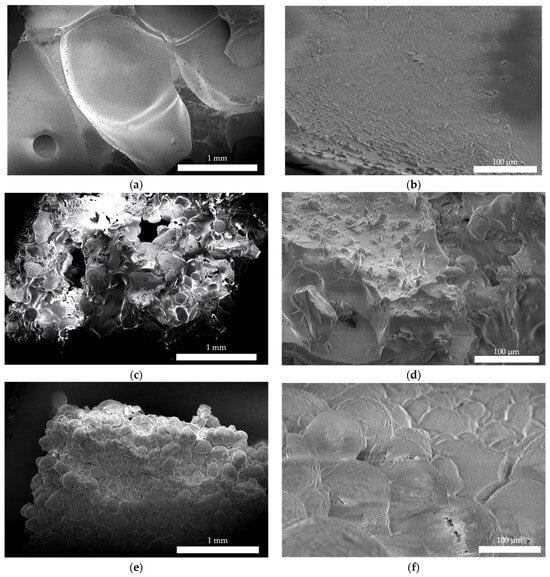
Figure 6.
Comparison of SEM analysis of CaL-PDMS foams: (a,b) FM0 without filler; (c,d) composite FM50; (e,f) composite FM70.
Figure 6a,b shows SEM micrographs of the unfilled PDMS composite, illustrating a small cross-sectional area of the foam. Circular voids are observed (Figure 6a—FM0), exhibiting a diameter of approximately 1.40 mm and a depth of 0.407 mm, separated by polymeric walls with different thicknesses, ranging from 0.305 mm to 0.023 mm. The internal surface of a void is characterized by a smooth morphology with some irregularities and the absence of fractures on the surface (see Figure 6b). An increase in the surface roughness of the siloxane composite is observed in samples with 50 wt.% CaL content (FM50); a non-smooth surface with regular roughness features across the composite, in addition to the formation of small surface voids with an average diameter of 0.077 mm (see Figure 6c,d). Upon increasing the CaL content to its maximum in the composite (FM70, Figure 6e,f), an increase in the surface roughness of the polymeric matrix is observed, resulting in small surface voids with an average size of 0.022 mm. Similar to FM50, a cluster of single particles of CaL grains with an irregular shape of 2400 µm (see Figure S1 in the SI) is not visible on the surface of the matrix, and no evidence of structural defects, large heterogeneities, or fractures on the surface is observable. Thus, it can be concluded that the dehydrated CaL cluster grains are completely embedded and homogenized within the PDMS composite, confirming the obtained results of the FTIR analyses discussed above.
Density measurements involved determining both the bulk and apparent densities. The bulk density (ρbulk) of the CaL-PDMS foam composite was measured at 20 °C using a pycnometer under a nitrogen atmosphere. The apparent density (ρapp) was derived from the mass and geometric volume of the synthesized samples. The internal porosity of the siloxane polymeric matrix was subsequently calculated using these ρapp and ρbulk values, as defined by Equation (2) [].
Figure 7 compares the evolution of the density of the composites and their porosity with the amount of CaL. The density of the composites increased progressively with the amount of calcium lactate (CaL) added to the polymer matrix, ranging from 0.132 g/cm3 for the unfilled sample (FM0) to 1.403 g/cm3 for the composite with the highest CaL content (FM70). In contrast, the porosity of the composites followed an inverse trend, decreasing (64.08% to 47.06%) as the CaL content increased.
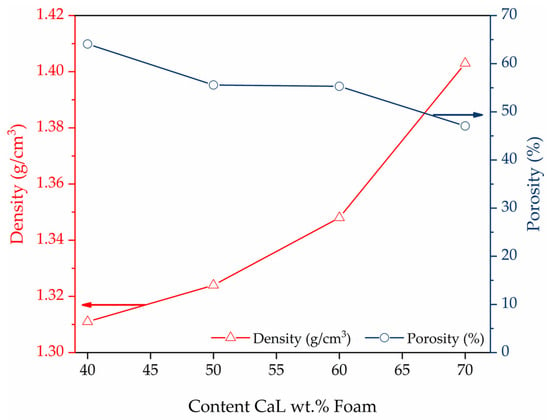
Figure 7.
Microstructural analysis of CaL-PDMS foams. Comparison between bulk density (blue line) and the percentage of porosity (red line).
These results are in agreement with the bubble distribution macrostructure, where higher CaL concentrations slightly suppress the foaming phenomenon, resulting in denser structures characterized by smaller and more tightly packed bubbles. Moreover, the observed increase in density and reduction in porosity are consistent with the results reported by Brancato et al. [], who reported a similar trend in an increase in the density of PDMS composites as the inorganic salt (MgSO4·7H2O) content increases.
To determine how the amount of organic salt embedded in the polymer matrix affects the evolution of the morphology and size of the voids in the composite structure, statistical analysis was performed using bubble distribution maps (discussed previously; see Figure 5), where the average void size parameters and the coefficient of variance (CoV) are reported in Figure 8 and listed in Table 2. The CoV represents the metric for quantifying the uniformity and consistency of the bubble size within the PDMS composite foam. Lower CoV values indicate a more uniform bubble circularity compared to a higher CoV value []. Composite CaL-PDMS foams showed a modification in pore size and morphology, shifting from larger voids to smaller spherical voids as the amount of dehydrated salt increased. This morphological aspect suggests a lower degree of void agglomeration and a more homogeneous internal structure for the highly filled composite foams. This behavior can be related to the increased addition of CaL to the composite (FM70), which was accompanied by a corresponding rise in ethanol content. Figure 8 depicts the amount of ethanol (g) used as the CaL content in the composite increases (green solid line). This approach was employed to promote the formation of a more homogeneous slurry.
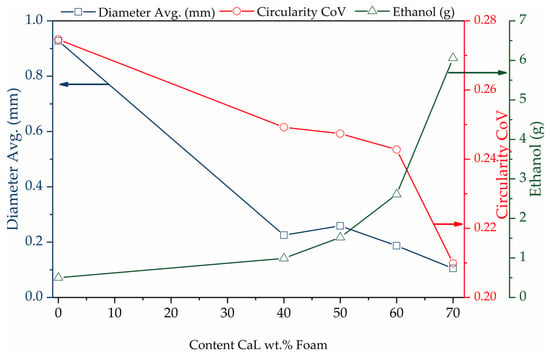
Figure 8.
Evolution of statistical analysis of void distribution with different amounts of dehydrated salt within composite CaL-PDMS foams. Comparison of diameter average (mm), circularity CoV, and ethanol (g) quantity.

Table 2.
Comparison of average diameter of voids in mm and their circularity size.
From Figure 8, it can be observed that the FM0 sample exhibited high circularity and a large bubble size, thus suggesting the agglomeration of voids within the silicone matrix during the foaming process. This also implies that the foaming and crosslinking reactions progressed in a way that allowed the voids to agglomerate into more stable spherical structures [].
The addition of CaL to the siloxane matrix led to a remarkable reduction in the size and circularity of the bubbles (see Table 2 and Figure 8). Specifically, foam FM40 (with 40% by weight of CaL) showed a 75.7% decrease in pore diameter (0.702 mm) and a 9.1% decrease in circularity (0.025), indicating a more compact and less uniform pore structure. As the dehydrated salt content increased, a continuous decrease in pore diameter was observed, with a decrease in circularity not that significant. Indeed, at the highest amount of CaL (FM70), the circularity is reduced by 23.72% (0.065), without exhibiting elongation in the foam bubbles or a more compacted height compared to the other samples.
This trend could be explained by the progressively higher amount of ethanol in the slurry for its homogenization. Indeed, the higher the solvent content, the slower the drying under the same conditions, thus leading to a more controlled foaming process, avoiding the coalescence of voids, and resulting in a more homogenous microporous structure with a reduced average pore diameter.
3.3. Hydration–Dehydration Thermochemical Behavior
Cyclic reversible hydration–dehydration isotherm curves were obtained at 30 °C by varying the relative humidity of the chamber between 0% and 90% using a thermogravimetric dynamic vapor system to evaluate the thermochemical behavior of the CaL-PDMS foams. The FM0 sample (without filler), in this context, was observed to serve purely as a structural support, exhibiting no intrinsic capacity for water vapor adsorption []. The mass change, expressed as water uptake (%), was analyzed using the initial mass of the CaL-PDMS composite sample. For all samples, analysis of the adsorption branch of the isotherm curve (represented by the solid line in the plot; see Figure 9) revealed a relatively low mass change—less than 5%—at relative humidity (RH) levels between 0% and 50%. Although a slight increasing trend with increasing CaL content in the foam can be observed, the differences among the samples in this RH range are minimal and not statistically significant. This behavior reflects the inherently low hygroscopicity of the PDMS matrix and the limited water adsorption capacity of the composite structure under moderate humidity conditions. However, under high humidity conditions (for RH values > 60%), the water uptake increases substantially across all samples, with the magnitude of this increase strongly correlated to the amount of CaL incorporated into the composite, as the higher the CaL content, the higher the water uptake.
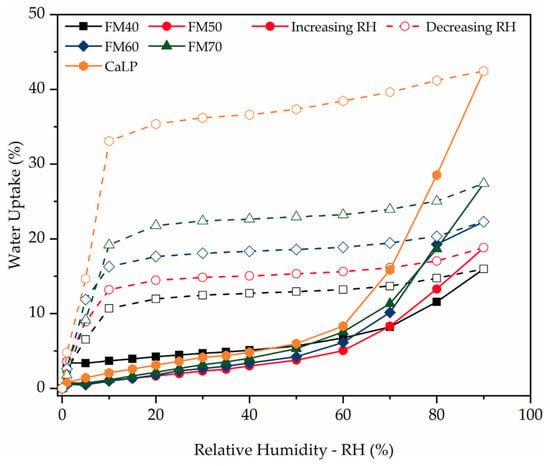
Figure 9.
Hydration–dehydration thermochemical behavior of composite CaL-PDMS foams. Comparison of reversible hydration–dehydration cycle isotherm at 30 °C between 0 and 90% RH and CaL blank.
Specifically, the FM40 sample exhibited a maximum water uptake of 15.76%, while FM70 reached 30.22%, as illustrated in Figure 9. This significant rise in sorption capacity at elevated RH levels is attributed to the hygroscopic nature of calcium lactate, which readily absorbs water in heavy humid environments []. In contrast, during the desorption phase, represented by the dotted line in the isotherm curve (Figure 9), the composites exhibited a noticeable decrease in water release only at very low relative humidity levels (below 10% RH), regardless of the CaL load in the material. This behavior indicates that, once adsorbed, water is largely retained within the material and is not readily released under largely humid conditions. Desorption becomes significant only in dry environments, suggesting a strong water-holding capacity that is highly relevant for building applications systems. As a result, when evaluating the complete adsorption–desorption cycles, a pronounced hysteresis loop was observed across all samples. In other words, the physical bonding between water molecules and salt within the polymer matrix is not easily reversible under moderate humidity reductions. In this study, we reported a water uptake of CaL 43.50%, corresponding to the adsorption of approximately 5.27 water molecules per unit. These results are consistent with the CaL content in each formulation, considering the pure CaL powder demonstrated previously by our group []. Thus, the observed trend confirms the role of CaL as the primary water-absorbing component in the composites (Equation (3)), with higher loadings directly enhancing the overall moisture sorption performance. To better understand the water sorption performance of the CaL-PDMS composites, Table 3 reports the amount of water uptake (%) at maximum relative humidity (90% RH), along with the corresponding number of H2O molecules adsorbed normalized to the amount of CaL in the composite and in the total mass of each composite. These values are compared with the theoretically expected water uptake and number of water molecules (Equation (4)) as if all the salt embedded in the composite had been hydrated–dehydrated during the cycle, calculated as follows:
where and are the molecular mass of CaLP (in its pentahydrate form, namely, 308.30 g/mol) and CaL (in its dehydrated form, namely, 218.22 g/mol), respectively, and is the fraction of the CaL in the composite. In the case of pure salt (i.e., = 1), = 41.2%.

Table 3.
Comparison of thermochemical behavior during hydration–dehydration cycle of CaL-PDMS foams.
The normalized water absorption (%) relative to the CaL content (wt.%) in the composite reflects both the percentage of CaL activated in water absorption and the number of water molecules adsorbed during hydration. This indicates hydration extent compared to the expected adsorption of five water molecules, attributed to the formation of a water coordination sphere around the CaL molecules. This phenomenon is promoted by the specific structural arrangement within the CaL, where lactate anions coordinate three calcium atoms and form hydrogen bonds with water molecules [,]. From the results, it is evident that the salt embedded in the matrix almost completely reacted.
The non-normalized water uptake results are aligned closely with the theoretical expectations based on the load of organic salt. A 51.36% increase in water molecule adsorption was noted when comparing the composite with the lowest CaL content to that with the highest organic salt content (see Table 3). The data revealed a consistent trend (normalized to the composite mass) of increasing water adsorption percentage with higher CaL content in the polymer matrix.
Long-term stability under cyclic thermal and mechanical stress is a critical requirement for energy storage systems in building sector applications. This paper focuses on the physicochemical and thermochemical behavior of CaL PDMS foam composites. An assessment of their mechanical behavior and long-term durability under cyclic conditions is currently being conducted in our research group.
3.4. Dehydration Enthalpy Behavior
The dehydration enthalpy behavior (i.e., heat adsorption) of composite CaL-PDMS foams was evaluated using a coupled TGA/DSC during an isothermal process at 80 °C (dehydration of the composite) under an inert atmosphere. Figure 10 illustrates the endothermic behavior of the dehydration enthalpy (solid blue line) during the heating of an isothermal process, in relation to temperature evolution (dotted black line) and percentage weight change (solid green line) for CaL-PDMS composites with minimum and maximum filler contents (FM40 and FM70). The isothermal dehydration process (heat storage) reveals different thermal events, yielding total enthalpy values of 430.58 kJ/kg and 860.51 kJ/kg, corresponding to weight losses of 11.3% and 19.6% for FM40 and FM70, respectively, as determined by integrating the endothermic peak (blue line).
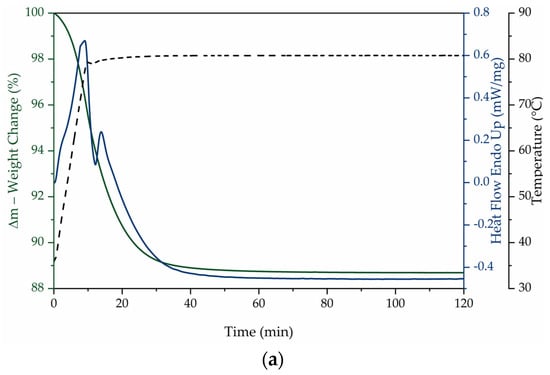

Figure 10.
Comparison of dehydration enthalpy behavior of composite CaL-PDMS foams with different amounts of filler in the polymeric matrix. (a) FM40, (b) FM70, (c) deconvoluted peak of FM40, and (d) deconvoluted peak of FM70.
For the composite foam samples with minimum and maximum CaL contents (Figure 10a,b), a weight change evolution from 11.30% to 19.66% was observed. This suggests that higher CaL content results in greater mass loss, indicating increased water desorption (from 1.54 to 2.97 water molecules). Such values are comparable to the maximum hydration capacity observed for both samples and in agreement with the expected theoretical weight change normalized to salt load in the matrix, as calculated by the equation (see Table 4). Figure 10b shows that the dehydration process was faster for FM40, which exhibited stable behavior after 40 min of testing. In contrast, sample FM70 (Figure 10c) required more than 60 min to reach a stability plateau.

Table 4.
Energy density storage performance of composites with different amounts of organic salt.
On the other hand, as observable in Figure 10c,d, the DSC heat flow profiles of the investigated samples (FM40 and FM70) showed three endothermic events, implying that heat absorption involves different phenomena. Consequently, deconvolution of the signal was performed using a pseudo-Voigt profile method, which combines Gaussian and Lorentzian curves (see Figure 10c,d and Figure S2 in the SI). A similar fit has been used in the literature to describe the absorption and desorption behaviors of other molecules []. For pure CaL, the presence of a maxima peak suggests that the desorption of water molecules adsorbed on the CaL surface occurs first, followed by those adsorbed within the bulk of the material [].
In the analysis of composite samples (FM40 and FM70), three distinct peaks were observed during the CaL dehydration process at temperatures of 37.67 °C, 69.78 °C, and 78.07 °C. Several mechanisms have been proposed for the dehydration of CaL. Mahlin et al. [] identified three key processes: surface changes in CaL, the formation of dispersed crystalline nanostructures within amorphous CaL, and the growth of a crystalline structure. These processes may correspond to the desorption of molecules from the surface, the release of water molecules from the bulk of CaL on the foam’s surface, and the release of molecules absorbed by the CaL located deeper within the composite. Sakata et al. [] propose that the dehydration mechanism of CaL is influenced by the nucleation frequency, which leads to an increase in the size of the CaLP crystal. This mechanism indicates that the surface of CaL is rougher compared to that of CaLP (see Figure S1 of the SI). The average size of the CaL grain clusters of CaLP is 0.24 mm, while for CaL, it increases to 0.35 mm. Furthermore, it is evident that the surface transitions from slightly smooth (in CaLP) to rougher after dehydration. The roughness observed in CaL may be attributed to the formation of nanostructured crystals that are dispersed within the amorphous material, followed by the agglomeration of these crystalline structures.
Table 4 shows a comparative overview of the enthalpy behavior (kJ/kg) and the volumetric heat storage capacity (MJ/m3), normalized to the amount of CaL (wt.%) and the composite mass. The volumetric storage was calculated using Equation (5). The total number of desorbed water molecules during dehydration was calculated using Equation (6), which relies on the theoretical mass change associated with the dehydration of one mole of CaL ( Equation (6)) [].
The results indicate a trend in the heat storage capacity (per unit mass) and density storage (per unit volume). An increase of 61.31% in volumetric storage was observed between the composite with the lowest CaL content (FM40) and the one with maximum filler loading (FM70), reaching values of 380 ± 4.9 MJ/m3 and 955 ± 12.6 MJ/m3, respectively. However, a 37.84% reduction in enthalpy behavior was noted compared to pure CaL (1127 kJ/kg) concerning the maximum filler content in the composite (FM70). This reduction aligns with the dilution effect caused by the incorporation of hydrated inorganic salts within the PDMS foams, which naturally leads to a proportional decrease in the energy storage capacity relative to the CaL content []. The results further highlight that the potential heat storage capacity of the salt is unaltered when dispersed in the matrix, thus establishing the PDMS foam as a proper candidate for this kind of application. Indeed, these composites have an inherent porous structure that allows for efficient water vapor transfer, which is a critical property for thermal energy storage.
The CaL-PDMS foam composite, with its maximum filler content, is compared to other composite materials that can be applied in the construction sector. Table 5 compares the results of their hydration–dehydration enthalpy with the behavior of different composites. As evidenced, most of the materials are PCMs. The CaL-PDMS composite (FM70) exhibits, in most cases, lower enthalpy (in terms of kJ per kg of composite material) compared to composites containing inorganic hydrated salts. However, it should be noted that this is the first composite to use an organic salt with TCES properties, thereby avoiding the undesirable deliquescence effects seen in other composites. Furthermore, the frequent use of chlorides can potentially be detrimental to the building structure itself.

Table 5.
Comparison of enthalpy behavior of different composite materials that can be applied in the construction sector.
4. Conclusions
This study presents a viable method for fabricating novel composite materials by incorporating calcium L-lactate (CaL) as a functional filler within a permeable PDMS matrix. The analysis of void distribution across varying CaL concentrations revealed a consistent average circularity of 0.23 and a significant reduction in average void size (88.7%), indicating that the microstructure can be tuned through filler loading. As the CaL content increased, the porosity of the foam decreased, which facilitated efficient water vapor transfer, an essential feature for thermal energy storage applications. Microscopic (ESEM) and spectroscopic (FTIR) analyses confirmed the uniform dispersion and effective homogenization of CaL within the polymer matrix, demonstrating good interfacial compatibility. ESEM imaging also showed that higher CaL concentrations induced controlled surface roughening without compromising structural integrity, as no defects or macrofractures were observed. The filler remained fully confined within the matrix, allowing the composite to undergo reversible dehydration–hydration cycles without performance loss, making it suitable for low-temperature thermochemical energy storage (TCES). The composite with the highest CaL loading achieved a volumetric heat storage capacity of 991 MJ/m3. Although some trade-off in energy density is expected when dispersing active components within a polymer matrix, this approach enhances mechanical stability and processability, key factors for practical applications.
Overall, the results highlight the potential of calcium lactate as a functional component in composite materials for thermopassive regulation in building structures, contributing to reduced CO2 emissions. Future work will focus on integrating this material into a sandwich structure and evaluating its mechanical properties.
Supplementary Materials
The following supporting information can be downloaded at https://www.mdpi.com/article/10.3390/en18225940/s1. Figure S1: SEM micrographs of calcium L-lactate pentahydrate. (a,b) calcium L-lactate pentahydrate; (c,d) calcium L-lactate hydrate at 90% relative humidity, Figure S2: Enthalpy behavior during dehydration. Comparison of Enthalpy with respect to temperature for (a) FM40, (c) FM50, (e) FM60, and (g) FM70; Deconvolutions of the heat flow of the composites during dehydration for (b) FM40, (d) FM50, (f) FM60, and (h) FM70, Table S1: List of dehydration heat flow peaks of the composites for performing the fitting process.
Author Contributions
Conceptualization, E.M. and L.C.; methodology, M.Á.-G. and E.P.; validation, E.M., L.C. and C.M.; formal analysis, M.Á.-G., I.A. and M.O.; investigation, M.Á.-G.; resources, E.M., L.C. and C.M.; data curation, M.Á.-G.; writing—original draft preparation, M.Á.-G., I.A. and M.O.; writing—review and editing, E.M. and L.C.; supervision, E.M., L.C. and C.M. All authors have read and agreed to the published version of the manuscript.
Funding
The present work is funded by the European Union’s NextGenerationEU in the framework of PNRR—Missione 4, Componente 2, and Investimento 1.1—Bando PRIN 2022 project GThESS, “Geopolymers Concrete Thermochemical Energy Storage Sandwich for Building Application”, CUP J53D23003420 006. M. Orfila thanks the Ministerio de Ciencia, Innovación y Universidades for José Castillejo para jóvenes doctores grant (CAS23/00346).
Data Availability Statement
The raw data are available from the corresponding author and will be provided to interested researchers upon request, without undue reservation.
Acknowledgments
We thank Daniela Iannazzo and Federica Bucolo at the University of Messina Engineering Department for their collaboration in training on the use of the ATR-FTIR (Spectrum Two Perkin Elmer) spectra equipment.
Conflicts of Interest
The authors declare no conflicts of interest. The funders had no role in the design of the study; in the collection, analyses, or interpretation of the data; in the writing of the manuscript; or in the decision to publish the results.
References
- European Parliament and the Council of the European Union. Directive (EU) 2024/1275 of the European Parliament and of the Council on the Energy Performance of Buildings; 2024. Available online: https://eur-lex.europa.eu/eli/dir/2024/1275/oj (accessed on 20 October 2025).
- Huang, Q.; Aftab, W.; Cheng, Y.; Li, Y. Form-Stable Metal Ion Coordination Organic Sorbent Aerogel and Its Application in Low Temperature Microwave-Powered Sorption Thermochemical Energy Storage. J. Energy Storage 2025, 114, 115810. [Google Scholar] [CrossRef]
- Gordeeva, L.G.; Aristov, Y.I. Composites “salt inside Porous Matrix” for Adsorption Heat Transformation: A Current State-of-the-Art and New Trends. Int. J. Low-Carbon Technol. 2012, 7, 288–302. [Google Scholar] [CrossRef]
- Zbair, M.; Bennici, S. Survey Summary on Salts Hydrates and Composites Used in Thermochemical Sorption Heat Storage: A Review. Energies 2021, 14, 3105. [Google Scholar] [CrossRef]
- Zheng, C.; Huang, Z.; Wang, D.; Ju, Z.; Zhang, Z.; Zhang, H.; Zhu, Y.; Jiang, Z. Synthesis and Properties of Biomass Derived Carbon/PEG Composite as Photothermal Conversion Effective Phase Change Material for Functional Concrete. Cem. Concr. Compos. 2024, 149, 105495. [Google Scholar] [CrossRef]
- Duan, S.; Wang, L.; Zhao, Z.; Zhang, C. Experimental Study on Thermal Performance of an Integrated PCM Trombe Wall. Renew Energy 2021, 163, 1932–1941. [Google Scholar] [CrossRef]
- He, J.W.; Huang, X.Y.; Shu, Z.Y.; Huang, R.N.; Cai, Y.; Lv, Y.; Zhao, F.Y. Preliminary Study of a Dual Channel Solar Photocatalytic Ventilation Wall System for Year-Round Air Purification and Building Energy Savings. J. Build. Eng. 2024, 82, 108261. [Google Scholar] [CrossRef]
- Gao, F.; Xiao, X.; Shu, Z.; Zhong, K.; Wang, Y.; Li, M. Investigation of Thermoregulation Effect of Stabilized Phase Change Gypsum Board with Different Structures in Buildings. Sustainability 2024, 16, 6929. [Google Scholar] [CrossRef]
- Jeong, S.G.; Wi, S.; Chang, S.J.; Lee, J.; Kim, S. An Experimental Study on Applying Organic PCMs to Gypsum-Cement Board for Improving Thermal Performance of Buildings in Different Climates. Energy Build. 2019, 190, 183–194. [Google Scholar] [CrossRef]
- Abbasi Hattan, H.; Madhkhan, M.; Marani, A. Thermal and Mechanical Properties of Building External Walls Plastered with Cement Mortar Incorporating Shape-Stabilized Phase Change Materials (SSPCMs). Constr. Build. Mater. 2021, 270, 121385. [Google Scholar] [CrossRef]
- Zhang, J.; Li, H.; Du, Y.; Xu, T.; Zou, T.; Wei, S.; Zhang, D. Development of CaCl2·6H2O-Mannitol/SiO2 Shape-Stabilized Composite Phase Change Material for the Radiant Cooling Panel System. Energy Build. 2024, 313. [Google Scholar] [CrossRef]
- Jiao, K.; Lu, L.; Zhao, L.; Wang, G. Towards Passive Building Thermal Regulation: A State-of-the-Art Review on Recent Progress of PCM-Integrated Building Envelopes. Sustainability 2024, 16, 6482. [Google Scholar] [CrossRef]
- Mastronardo, E.; La Mazza, E.; Palamara, D.; Piperopoulos, E.; Iannazzo, D.; Proverbio, E.; Milone, C. Organic Salt Hydrate as a Novel Paradigm for Thermal Energy Storage. Energies 2022, 15, 4339. [Google Scholar] [CrossRef]
- N’Tsoukpoe, K.E.; Schmidt, T.; Rammelberg, H.U.; Watts, B.A.; Ruck, W.K.L. A Systematic Multi-Step Screening of Numerous Salt Hydrates for Low Temperature Thermochemical Energy Storage. Appl. Energy 2014, 124, 1–16. [Google Scholar] [CrossRef]
- Michel, B.; Mazet, N.; Mauran, S.; Stitou, D.; Xu, J. Thermochemical Process for Seasonal Storage of Solar Energy: Characterization and Modeling of a High Density Reactive Bed. Energy 2012, 47, 553–563. [Google Scholar] [CrossRef]
- Grevel, K.D.; Majzlan, J. Internally Consistent Thermodynamic Data for Magnesium Sulfate Hydrates. Geochim. Cosmochim. Acta 2009, 73, 6805–6815. [Google Scholar] [CrossRef]
- Ferchaud, C.J.; Zondag, H.A.; Veldhuis, J.B.J.; De Boer, R. Study of the Reversible Water Vapour Sorption Process of MgSO 4.7H2O and MgCl2.6H2O under the Conditions of Seasonal Solar Heat Storage. J. Phys. Conf. Ser. 2012, 395, 012069. [Google Scholar] [CrossRef]
- Michel, B.; Neveu, P.; Mazet, N. Comparison of Closed and Open Thermochemical Processes, for Long-Term Thermal Energy Storage Applications. Energy 2014, 72, 702–716. [Google Scholar] [CrossRef]
- Frazzica, A.; Brancato, V.; Caprì, A.; Cannilla, C.; Gordeeva, L.G.; Aristov, Y.I. Development of “Salt in Porous Matrix” Composites Based on LiCl for Sorption Thermal Energy Storage. Energy 2020, 208, 118338. [Google Scholar] [CrossRef]
- Shervani, S.; Strong, C.; Tezel, F.H. Simultaneous Impregnation and Microencapsulation of CaCl2 Using Silica Gel and Methyl Cellulose for Thermal Energy Storage Applications. Sci. Rep. 2024, 14, 7183. [Google Scholar] [CrossRef]
- Liu, X.; Wang, H.; Liu, X.; Yang, F.; Guan, L.; Sani, S.; Sun, C.; Wu, Y. Development of MgSO4/Mesoporous Silica Composites for Thermochemical Energy Storage: The Role of Porous Structure on Water Adsorption. Energy Rep. 2022, 8, 4913–4921. [Google Scholar] [CrossRef]
- Fenwick, O.; Coutiño-Gonzalez, E.; Grandjean, D.; Baekelant, W.; Richard, F.; Bonacchi, S.; De Vos, D.; Lievens, P.; Roeffaers, M.; Hofkens, J.; et al. Tuning the Energetics and Tailoring the Optical Properties of Silver Clusters Confined in Zeolites. Nat. Mater. 2016, 15, 1017–1022. [Google Scholar] [CrossRef] [PubMed]
- Hongois, S.; Kuznik, F.; Stevens, P.; Roux, J.J. Development and Characterisation of a New MgSO4-Zeolite Composite for Long-Term Thermal Energy Storage. Sol. Energy Mater. Sol. Cells 2011, 95, 1831–1837. [Google Scholar] [CrossRef]
- Whiting, G.; Grondin, D.; Bennici, S.; Auroux, A. Heats of Water Sorption Studies on Zeolite-MgSO4 Composites as Potential Thermochemical Heat Storage Materials. Sol. Energy Mater. Sol. Cells 2013, 112, 112–119. [Google Scholar] [CrossRef]
- Yang, X.; Li, S.; Zhao, J.; Wang, X.; Huang, H.; Wang, Y.; Deng, L. Development of Lithium Hydroxide-Metal Organic Framework-Derived Porous Carbon Composite Materials for Efficient Low Temperature Thermal Energy Storage. Microporous Mesoporous Mater. 2021, 328, 111455. [Google Scholar] [CrossRef]
- Carrillo, A.J.; González-Aguilar, J.; Romero, M.; Coronado, J.M. Solar Energy on Demand: A Review on High Temperature Thermochemical Heat Storage Systems and Materials. Chem. Rev. 2019, 119, 4777–4816. [Google Scholar] [CrossRef] [PubMed]
- Padamurthy, A.; Nandanavanam, J.; Rajagopalan, P. Preparation and Characterization of Metal Organic Framework Based Composite Materials for Thermochemical Energy Storage Applications. Appl. Surf. Sci. Adv. 2022, 11, 100309. [Google Scholar] [CrossRef]
- Zhou, S.W.; Xia, C.C.; Hu, Y.S.; Zhou, Y.; Zhang, P.Y. Damage Modeling of Basaltic Rock Subjected to Cyclic Temperature and Uniaxial Stress. Int. J. Rock Mech. Min. Sci. 2015, 77, 163–173. [Google Scholar] [CrossRef]
- Li, K.-S.; Chen, L.-X.; Yang, S.-Q.; Song, G.-L. Multiscale Deterioration of Physical and Triaxial Mechanical Behaviors of Fine-Grained Sandstone Under Cyclic Freezing–Thawing: Experimental Observation and Microstructural Interpretation. Rock Mech. Rock Eng. 2025, 58, 10827–10851. [Google Scholar] [CrossRef]
- Park, S.J.; Jin, F.L.; Park, J.H.; Kim, K.S. Synthesis of a Novel Siloxane-Containing Diamine for Increasing Flexibility of Epoxy Resins. Mater. Sci. Eng. A 2005, 399, 377–381. [Google Scholar] [CrossRef]
- Taherizadeh, A.; Simon, A.; Richter, H.; Stelter, M.; Voigt, I. Development and Investigation of a Multilayer PDMS/Zeolite Composite Membrane for CO2 Separation Applications. Sep. Purif. Technol. 2024, 346, 127344. [Google Scholar] [CrossRef]
- Fauvel, M.; Trybala, A.; Tseluiko, D.; Starov, V.M.; Bandulasena, H.C.H. Stability of Two-Dimensional Liquid Foams under Externally Applied Electric Fields. Langmuir 2022, 38, 6305–6321. [Google Scholar] [CrossRef]
- Zambotti, A.; Valentini, F.; Lodi, E.; Pegoretti, A.; Tyrpekl, V.; Kohúteková, S.; Sorarù, G.D.; Kloda, M.; Biesuz, M. Thermochemical Heat Storage Performances of Magnesium Sulphate Confined in Polymer-Derived SiOC Aerogels. J. Alloys Compd. 2022, 895, 162592. [Google Scholar] [CrossRef]
- Mastronardo, E.; Piperopoulos, E.; Palamara, D.; Frazzica, A.; Calabrese, L. Morphological Observation of LiCl Deliquescence in PDMS-Based Composite Foams. Appl. Sci. 2022, 12, 1510. [Google Scholar] [CrossRef]
- Calabrese, L.; Palamara, D.; Piperopoulos, E.; Mastronardo, E.; Milone, C.; Proverbio, E. Deviceful LiCl Salt Hydrate Confinement into a Macroporous Silicone Foam for Low-Temperature Heat Storage Application. J. Sci. Adv. Mater. Devices 2022, 7, 100463. [Google Scholar] [CrossRef]
- He, X.; Yang, M.; Hu, F.; Jiang, G.; Shen, Y. Comparative Study on the Foaming and Fireproof Properties of PDMS Foam Composites with Different Inorganic Fillers. Buildings 2025, 15, 1172. [Google Scholar] [CrossRef]
- You, L.; Liu, B.; Hua, H.; Jiang, H.; Yin, C.; Wen, F. Energy Storage Performance of Polymer-Based Dielectric Composites with Two-Dimensional Fillers. Nanomaterials 2023, 13, 2842. [Google Scholar] [CrossRef] [PubMed]
- Kang, Y.H.; Bae, E.J.; Lee, M.H.; Han, M.; Kim, B.J.; Cho, S.Y. Highly Flexible and Durable Thermoelectric Power Generator Using CNT/PDMS Foam by Rapid Solvent Evaporation. Small 2022, 18, 2106108. [Google Scholar] [CrossRef]
- Chhetri, S.; Nguyen, A.T.; Song, S.; Gaillard, N.; Severa, G.; Ma, T.; Yoon, S.H.; Lee, W. Flexible Graphite Nanoflake/Polydimethylsiloxane Nanocomposites with Promising Solar-Thermal Conversion Performance. ACS Appl. Energy Mater. 2023, 6, 2582–2593. [Google Scholar] [CrossRef]
- De Maere D’aertrycke, J.B.; Morlot, J.; Robeyns, K.; Filinchuk, Y.; Leyssens, T. Exploring the Solid-State Phases and Thermodynamics of Calcium L-Lactate. Food Chem. 2020, 325, 126884. [Google Scholar] [CrossRef] [PubMed]
- Sakata, Y.; Shiraishi, S.; Otsuka, M. Characterization of Dehydration and Hydration Behavior of Calcium Lactate Pentahydrate and Its Anhydrate. Colloids Surf. B Biointerfaces 2005, 46, 135–141. [Google Scholar] [CrossRef]
- Mastronardo, E.; Previti, E.; Calabrese, L.; Milone, C. Experimental Assessment of Calcium L-Lactate as Thermochemical Heat Storage Material. J. Energy Storage 2025, 108, 115065. [Google Scholar] [CrossRef]
- Calabrese, L.; Brancato, V.; Palomba, V.; Frazzica, A.; Cabeza, L.F. Assessment of the Hydration/Dehydration Behaviour of MgSO4∙7H2O Filled Cellular Foams for Sorption Storage Applications through Morphological and Thermo-Gravimetric Analyses. Sustain. Mater. Technol. 2018, 17, e00073. [Google Scholar] [CrossRef]
- Miao, K.; Lu, Z.; Cao, J.; Zhang, H.; Li, D. Effect of Polydimethylsiloxane on the Mid-Temperature Strength of Gelcast Al2O3 Ceramic Parts. Mater. Des. 2016, 89, 810–814. [Google Scholar] [CrossRef]
- De Souza Neto, F.N.; Araújo, O.A.; Guilherme, L.R.; Garg, V.K.; Oliveira, A.C.; De Souza, P.E.N.; Franco Júnior, A. Particles That Slide over the Water Surface: Synthesis and Characterization of Iron Oxides Particles Coated with PDMS, with Hydrophobic and Magnetic Properties. Mater. Chem. Phys. 2015, 162, 100–105. [Google Scholar] [CrossRef]
- Brancato, V.; Calabrese, L.; Palomba, V.; Frazzica, A.; Fullana-Puig, M.; Solé, A.; Cabeza, L.F. MgSO4·7H2O Filled Macro Cellular Foams: An Innovative Composite Sorbent for Thermo-Chemical Energy Storage Applications for Solar Buildings. Sol. Energy 2018, 173, 1278–1286. [Google Scholar] [CrossRef]
- Baglioni, M.; Bartoletti, A.; Bozec, L.; Chelazzi, D.; Giorgi, R.; Odlyha, M.; Pianorsi, D.; Poggi, G.; Baglioni, P. Nanomaterials for the Cleaning and PH Adjustment of Vegetable-Tanned Leather. Appl. Phys. A Mater. Sci. Process 2016, 122, 1–11. [Google Scholar] [CrossRef]
- Calabrese, L.; Brancato, V.; Frazzica, A. Experimental Evaluation of the Hydrothermal Stability of a Silicone/Zeolite Composite Foam for Solar Adsorption Heating and Cooling Application. J. Appl. Polym. Sci. 2020, 137. [Google Scholar] [CrossRef]
- Chen, C.; Yu, H.; Lai, T.; Guo, J.; Qin, M.; Qu, Z.; Feng, Y.; Feng, W. Flexible and Elastic Thermal Regulator for Multimode Intelligent Temperature Control. SusMat 2023, 3, 843–858. [Google Scholar] [CrossRef]
- Krom, J.; Meister, K.; Vilgis, T.A. Simple Method to Assess Foam Structure and Stability Using Hydrophobin and BSA as Model Systems. ChemPhysChem 2024, 25, e202400050. [Google Scholar] [CrossRef] [PubMed]
- Tan, B.; Cai, J.; Cheng, S. Bubble Characterization and Bubble Population on SiC Material Surface in Subcooled Boiling Flow. Int. J. Therm. Sci. 2025, 208, 109447. [Google Scholar] [CrossRef]
- Calabrese, L.; Bonaccorsi, L.; Bruzzaniti, P.; Gullì, G.; Freni, A.; Proverbio, E. Zeolite Filled Siloxane Composite Foams: Compression Property. J. Appl. Polym. Sci. 2018, 135, 46145. [Google Scholar] [CrossRef]
- Liao, W.; Wang, P.; Xu, Z.; Huang, X. Microfluidic Foaming of Polydimethylsiloxane (PDMS). Mater. Lett. 2025, 379, 137653. [Google Scholar] [CrossRef]
- Haily, E.; Ait Ousaleh, H.; Zari, N.; Faik, A.; Bouhfid, R.; Qaiss, A. Use of a Form-Stable Phase Change Material to Improve Thermal Properties of Phosphate Sludge-Based Geopolymer Mortar. Constr. Build. Mater. 2023, 386, 131570. [Google Scholar] [CrossRef]
- Tieger, E.; Kiss, V.; Pokol, G.; Finta, Z.; Dušek, M.; Rohlíček, J.; Skořepová, E.; Brázda, P. Studies on the Crystal Structure and Arrangement of Water in Sitagliptin L-Tartrate Hydrates. CrystEngComm 2016, 18, 3819–3831. [Google Scholar] [CrossRef]
- Al-Jalali, M.A.; Aljghami, I.F.; Mahzia, Y.M. Voigt Deconvolution Method and Its Applications to Pure Oxygen Absorption Spectrum at 1270 Nm Band. Spectrochim. Acta Part A Mol. Biomol. Spectrosc. 2016, 157, 34–40. [Google Scholar] [CrossRef]
- Mahlin, D.; Berggren, J.; Alderborn, R. Moisture-Induced Surface Crystallization of Spray-Dried Amorphous Lactose Particles Studied by Atomic Force Microscopy. J. Pharm. Sci. 2004, 93, 29–37. [Google Scholar] [CrossRef]
- Hekimoğlu, G.; Sarı, A.; Arunachalam, S.; Arslanoğlu, H.; Gencel, O. Porous Biochar/Heptadecane Composite Phase Change Material with Leak-Proof, High Thermal Energy Storage Capacity and Enhanced Thermal Conductivity. Powder Technol. 2021, 394, 1017–1025. [Google Scholar] [CrossRef]
- Moulakhnif, K.; Ait Ousaleh, H.; Sair, S.; Bouhaj, Y.; El Majd, A.; Ghazoui, M.; Faik, A.; El Bouari, A. Renewable Approaches to Building Heat: Exploring Cutting-Edge Innovations in Thermochemical Energy Storage for Building Heating. Energy Build. 2024, 318, 114421. [Google Scholar] [CrossRef]
- Wen, R.; Zhang, W.; Lv, Z.; Huang, Z.; Gao, W. A Novel Composite Phase Change Material of Stearic Acid/Carbonized Sunflower Straw for Thermal Energy Storage. Mater. Lett. 2018, 215, 42–45. [Google Scholar] [CrossRef]
- Fang, Y.; Ahmad, M.R.; Lao, J.C.; Qian, L.P.; Dai, J.G. Development of Artificial Geopolymer Aggregates with Thermal Energy Storage Capacity. Cem. Concr. Compos. 2023, 135, 104834. [Google Scholar] [CrossRef]
- Gencel, O.; Hekimoglu, G.; Sarı, A.; Ustaoglu, A.; Subasi, S.; Marasli, M.; Erdogmus, E.; Memon, S.A. Glass Fiber Reinforced Gypsum Composites with Microencapsulated PCM as Novel Building Thermal Energy Storage Material. Constr. Build. Mater. 2022, 340, 127788. [Google Scholar] [CrossRef]
- Erdogmus, E.; Yaras, A.; Ustaoglu, A.; Hekimoğlu, G.; Sarı, A.; Gencel, O. Thermal Performance Analysis of Novel Foam Concrete Composites with PCM for Energy Storage and Environmental Benefits in Buildings. Energy Build. 2023, 296, 113413. [Google Scholar] [CrossRef]
- Zhang, N.; Yuan, Y.; Wang, X.; Cao, X.; Yang, X.; Hu, S. Preparation and Characterization of Lauric-Myristic-Palmitic Acid Ternary Eutectic Mixtures/Expanded Graphite Composite Phase Change Material for Thermal Energy Storage. Chem. Eng. J. 2013, 231, 214–219. [Google Scholar] [CrossRef]
Disclaimer/Publisher’s Note: The statements, opinions and data contained in all publications are solely those of the individual author(s) and contributor(s) and not of MDPI and/or the editor(s). MDPI and/or the editor(s) disclaim responsibility for any injury to people or property resulting from any ideas, methods, instructions or products referred to in the content. |
© 2025 by the authors. Licensee MDPI, Basel, Switzerland. This article is an open access article distributed under the terms and conditions of the Creative Commons Attribution (CC BY) license (https://creativecommons.org/licenses/by/4.0/).